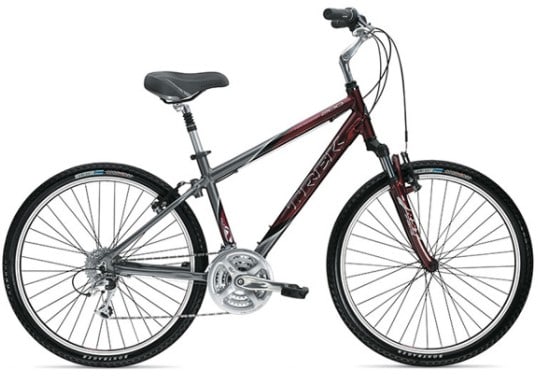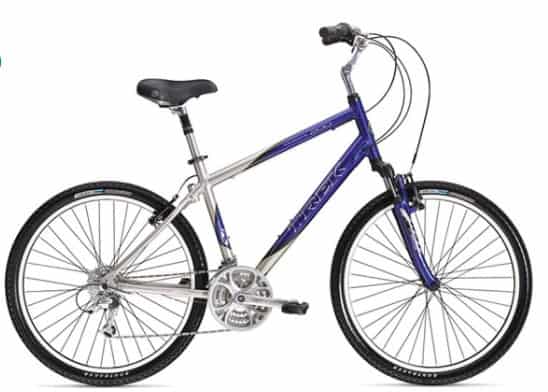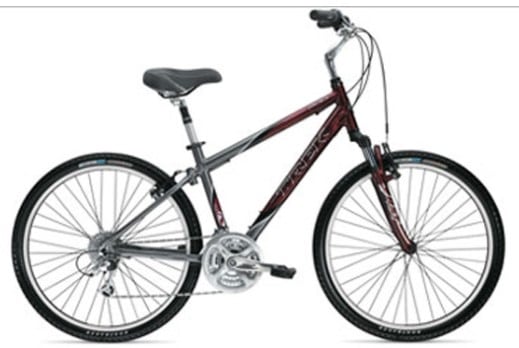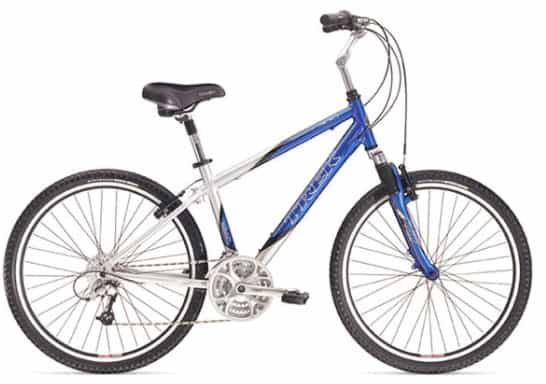Are you looking for a mountain bike-inspired comfort bike and don’t know what to go for? You should probably not look beyond Trek Navigator 200, and this Trek Navigator 200 review will help you choose.
Though Trek discontinued its manufacturing in 2006, not many Trek fans can forget the Navigator 200. This MTB- inspired comfort bike brings together the worlds of comfort and high performance, making it a worthwhile purchase.
It borrows a lot from the mountain bike, including the MTB’s robust wheels, lighter frames, and wide gearing to enable you to take on some off-road terrains confidently. Comfort-wise, the bike comes with a suspension seat post, cushy saddle, and suspension fork that considerably softens the bumps.
Like every other comfort bike, it enjoys an upright geometry to allow you to safely ride on urban roads while fixing your eyes on the road. And the best bit is that this comfort bike is a budget purchase.
But is the bike worth it? Why should you spend your money on an option that is no longer being produced?
We’ll answer everything in this very post.

Trek Navigator 200 Specs Overview
| Bike Type | Comfort bike |
| Frame Type | Alpha aluminum |
| Suspension | 50mm |
| Weight | 30 pounds |
| Wheel Size | 26 inch |
| Speed | 24 |
| Shifters | 8-speed SRAM |
| Crank | 48/3828 Shimano |
| Saddle | Bontrager-approved |
| Seat Post | Suspension seat post |
| Brakes | Tektro v-brakes |
| Handlebar | 50mm rise bar |
| Stem | Adjustable stem |
| Pedals | Dual-density platform |
About Trek Navigator 200
The Trek Navigator is an MTB-inspired comfort bike best for commuting, light off-road adventures, and fitness cycling.
This bike was initially unveiled in 1999 but discontinued by Trek in 2006. So, there are eight generations currently, all promising the same specs and performance.
Navigator 200 weighs about 30 pounds and comes in stylish colors. Among the most popular color choices are:
- Metallic red/metallic charcoal
- Titanite black/estate green
- Titanite black/wheat silver
- Metallic dark silver/metallic silver
Trek Navigator 200 comes in different frame sizes to accommodate riders of varying heights. Overall, this bike lives up to the label ‘comfort’ owing to its suspension seat post and fork, cushy saddles, upright geometry, and lightweight alpha aluminum frame.

Trek Navigator 200 Review of Best Features
Here are Trek Navigator 200’s selling points:
1. Quality Frame
Trek employs its innovative alpha aluminum technology on the Navigator 200’s frame to promise several benefits. For one, only high-grade carbon and titanium can beat alpha aluminum in strength, comfort, and lighter weight.
So, getting a Navigator 200 means having a strong enough bike to hold your vast weight, lightweight for easy maneuver, and comfortable to ride long-distance.
Overall, the frame enables the bike to hold up to 300 pounds, as it’s the case with most Trek bicycles. Even better, the alpha aluminum frame comes with a limited lifetime warranty. That only proves its quality artistry.
2. Decent Suspension Fork
Navigator 200 features a 50mm suspension fork whose job is to soak up road vibrations. It overall enables you to take on bumpier roads comfortably even when there are many rough patches.
3. Trek Navigator 200 Tire Size and Wheel Construction
Navigator 200 comes with 26×1.95 inch tires that smoothly roll over obstacles. Their biggest strength is their puncture resistance. These tires, which enjoy a Bontrager hard case design, reduce flats, making them reliable on harsh terrains.
The wheels also feature a set of Matrix 550 alloy rims that are pretty sturdy. They generally improve the bike’s sturdiness and strength, owing to their high-spoke count.
4. High-Performance Drivetrain
Navigator 200 comes with an 8-speed 11-32 cassette, 48/38/28 crank, and 8-speed shifters. The 8-speed cassette, together with the triple chainset, provides you with 24 gears. So, with 24 gears/speeds, you can shift into high and low gear smoothly and take about any terrain.

5. Quality Components
The components include:
a. Handlebars and Stem
This bike comes with the traditional MTB riser bar to sit upright and cycle comfortably. Even better, it enjoys an adjustable riser stem that you can adjust freely to find your comfortable handlebar height and angle.
b. Pedals
Navigator 200 comes with dual-density platform pedals that allow you to switch between styles quickly without the need to change the gears manually. Overall, these pedals let you cycle with regular shoes, and you can bail out any time. That’s how flexible the pedals are!
c. Seat
This comfort bike comes with a cushy saddle with spring suspension that enables you to ride comfortably. Generally, you can count on its saddle to not only relieve you from saddle soreness but also for bump absorption.
d. Seat Post
The cushy saddle works cohesively with the bike’s suspension seat post, absorbing a considerable amount of bumps. You can adjust the seat post suspension comfortably to allow you to take on rough roads.
e. Brakes
Trek includes a set of Tektro v-brakes on the bike line. For those who are used to hydraulic and mechanical disc brakes, the v-brakes may seem like a party spoiler.
Well, if this was a mountain bike, then you could worry about the brake’s performance in wet conditions. But since it’s a comfort bike, which you should ride on urban roads, you won’t have a problem bringing it to a stop.
Perhaps the only place where the brakes may disappoint you is muddy roads. That’s because they are not as strong as disc brakes to take on wet conditions.
6. Add-Ons
This bike comes with a bell for sounding your presence on urban roads and a chainring guard to protect the chain from slipping off or catching things. Thus, it’s commuter-ready.
Size (Trek Navigator 200 Size Chart)
Trek Navigator 200 comes in various frame sizes to suit different heights. So, you only need to pick a frame size that complements your height using the size chart below:
| Frame Size | Rider Height |
| 14.5 inches | 5’2”-5’6” |
| 16.5 inches | 5’6”-5’10” |
| 18.5 inches | 5’10”-6’1” |
| 21 inches | 6’1”-6’4” |
Trek Navigator 200 Vs 300
Trek Navigator 200 and Navigator 300 have so much in common, making it almost impossible to separate them. For one, these two comfort bikes come with an alpha aluminum frame, 26-inch wheels, and an 8-speed cassette.
They also feature Bontrager hard case tires, Tektro v-brakes, and dual-density platform pedals. Moreover, they come with a 50mm suspension fork, 50mm rise bar, and an adjustable stem.
So, it’s generally hard to find something that distinguishes them apart from their colors. But if you look keenly, the two differ in weight and rims.
While the Trek Navigator 200 weight is about 30 pounds, Navigator 300 weighs up to 35 pounds, depending on generation. So, Trek Navigator 300 is the weightier option of the two.
And when it comes to the rims, while Navigator 200 comes with matrix alloy 550 rims, Navigator 300 features 750mm rims which are slightly heavier but more robust. As a result, Navigator 300 is a better choice for aggressive climbing.
Some riders also claim that Trek Navigator 300 has better shifters, which is debatable given that they are all 8-speed.
Price-wise, Navigator 300 costs $400-$500 while Navigator 200 retails at $380-$420. That makes Navigator 200 is the cheaper option. You can, however, get either for cheap if you buy secondhand.

Trek Navigator 200 Review of Pros and Cons
Pros
- Lighter frames
- Stronger wheels
- Wide gear range
- Puncture-resistant tires
- Upright cycling
- Affordable price
- Beginner-friendly
- Commuter-ready
Cons
- Its Tektro v-brakes are not very reliable in muddy/wet conditions
- Not the best for steeper terrains
- It can be slightly slow
Is Trek Navigator 200 Hybrid Worth It?
There is no doubt that Navigator 200 is not the best for steeper terrains. It’s also true that it doesn’t have the most reliable brakes and can be slower.
But let’s face it, you cannot expect more from a bike that costs under $500. So, if you consider the specs and what you pay, you could conclude that the bike is worth it and quite a bargain.
Besides, it comes with an alpha aluminum frame, a wide-gear drivetrain, robust MTB-like wheels, a suspension seat post, and a cushy saddle. That’s comfort and quality right there!
Its comfort and quality build are unquestionable, and its versatility is second to none. So, this comfort bike is worth it for commuters, fitness cyclists, hobbyists, and just about anyone who plans to ride on urban roads.
Who Should Get Trek Navigator 200?
Navigator 200 is designed for the urban commuter. This bike comes commuter-ready, featuring a bell and a protective chainring guard.
Comfort-wise, the bike has everything you expect from a commuter bike. Not only does it enjoy an upright geometry, but it also comes with lots of suspensions. Its fork, saddle, and seat post feature shock-absorbing suspensions.
But still, its robust wheels and puncture-resistant tires make it best for light trails. That means you can also use it for fitness cycling, light trail biking, and running errands.
People Also Ask (Trek Navigator 200 Reviews)
1. How Much Is a Trek Navigator 200 Worth?
Depending on the store, bike generation, and size, a new Navigator 200 costs $380-$420. However, you may spend up to $200 for a secondhand option or even less for a trade-in.
2. What Year Did Trek Make the Navigator 200?
Trek made Navigator 200 in 1999 but discontinued the line in 2006, just after eight generations.
3. Does Trek Still Make the Navigator?
Unfortunately, No! Trek no longer makes the Navigator. However, they archive several lines, including Navigator 200, Navigator 300, Navigator 2.0, Navigator 400, and Navigator 500.
Also Read:
Concluding the Trek Navigator 200 Review:
Now you have an overview of what to expect from a Trek Navigator 200. This comfort bike, like every other, is not flawless, but if you consider its rich features and price, the bicycle is worth having at home.
You can choose to use it for your commuting, fitness cycling, running errands, and just about any use on urban roads.